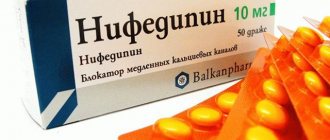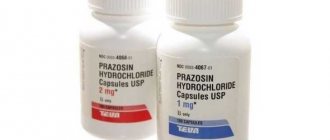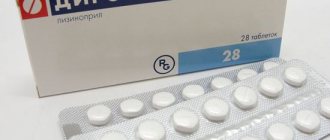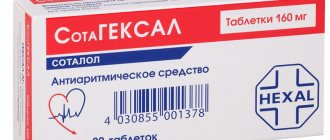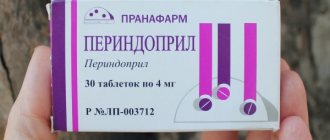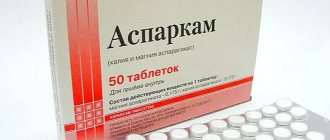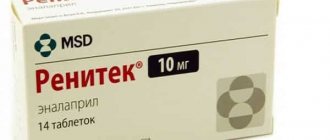Osmo-Adalat
From the cardiovascular system: tachycardia, arrhythmias, peripheral edema (ankles, feet, legs), manifestations of excessive vasodilation (asymptomatic decrease in blood pressure, “flushes” of blood to the facial skin, flushing of the facial skin, feeling of heat), excessive decrease in blood pressure (rarely), fainting , development or worsening of heart failure (usually worsening of an existing one). In some patients (especially with severe obstructive lesions of the coronary arteries), at the beginning of treatment or when the dose is increased, attacks of angina pectoris may occur, including the development of myocardial infarction (requires discontinuation of the drug).
From the nervous system: headache, dizziness, increased fatigue, asthenia, drowsiness. With long-term ingestion in high doses - paresthesia of the limbs, tremor, extrapyramidal (parkinsonian) disorders (ataxia, mask-like face, shuffling gait, stiffness of the arms or legs, tremor of the hands and fingers, difficulty swallowing), depression.
From the digestive system: dry mouth, increased appetite, dyspepsia (nausea, diarrhea or constipation); rarely - gum hyperplasia (bleeding, pain, swelling), with long-term use - liver dysfunction (intrahepatic cholestasis, increased activity of liver transaminases).
From the musculoskeletal system: rarely - arthralgia, swelling of the joints, myalgia.
From the hematopoietic organs: anemia, leukopenia, thrombocytopenia, thrombocytopenic purpura, asymptomatic agranulocytosis.
From the urinary system: increased daily diuresis, deterioration of renal function (in patients with renal failure).
Allergic reactions: rarely - itching, urticaria, exanthema, autoimmune hepatitis.
Local reactions: burning at the site of intravenous administration.
Other: rarely - visual impairment (including transient loss of vision against the background of Cmax in plasma), gynecomastia (in elderly patients, completely disappearing after withdrawal), galactorrhea, hyperglycemia, pulmonary edema (difficulty breathing, cough, wheezing), weight gain. Overdose. Symptoms: headache, flushing of the facial skin, prolonged pronounced decrease in blood pressure, suppression of sinus node function, bradycardia, bradyarrhythmia.
Treatment: in case of severe poisoning (collapse, depression of the sinus node), gastric lavage is performed and activated charcoal is prescribed. The antidote is Ca2+ preparations: slow intravenous administration of 10% CaCl2 or calcium gluconate is indicated, followed by switching to a long-term infusion.
With a pronounced decrease in blood pressure, dopamine or dobutamine is administered intravenously. For conduction disorders - atropine, isoprenaline or an artificial pacemaker. With the development of heart failure - intravenous administration of strophanthin. Catecholamines should be used only when there is a threat to life (due to their reduced effectiveness, a high dosage is required, which increases the risk of developing arrhythmia). It is recommended to monitor blood concentrations of glucose (insulin release may decrease) and electrolytes (K+, Ca2+).
Hemodialysis is ineffective.
Contraindications for use
After reading the instructions for Adalat, you can learn about contraindications to the use of this medicine. The following diseases and conditions are prohibited from taking the drug:
- Acute period of myocardial infarction (during the first 8 days);
- Hypersensitivity;
- Severe aortic stenosis;
- Cardiogenic shock;
- Severe arterial hypotension;
- Heart failure in the stage of decompensation;
- Tachycardia.
You should also not use Adalat during pregnancy and lactation.
It is not recommended to prescribe the drug to children and adolescents, since its effectiveness and safety for people under the age of 18 have not yet been sufficiently studied.
Due to the slow metabolism of Adalat components, people over 60 years of age should use the drug with caution. Such patients, as a rule, do not need dose adjustments. The same applies to patients with impaired renal function.
In case of liver function disorders, Osmo Adalat should be taken with caution. First of all, liver activity is monitored during treatment. If the functions of this organ are significantly impaired, the dosage of the medicine is reduced.
Osmo-adalat - special instructions
In patients with malignant arterial hypertension and hypovolemia on hemodialysis, an excessive decrease in blood pressure may occur while taking Osmo-Adalat.
In patients with severe gastrointestinal stenosis, the use of Osmo-Adalat tablets, which have an inelastic shell, can cause gastrointestinal obstruction.
Treatment of patients with impaired liver function with Osmo-Adalat should be carried out under conditions of careful medical supervision. In severe cases, it may be necessary to reduce the dosage of the medication.
In X-ray studies of the gastrointestinal tract using barium as a radiocontrast agent, Osmo-Adalat tablets can cause false-positive results for the presence of polyps.
When using Osmo-Adalat, a false increase in the results of spectrophotometric determination of the concentration of vanillyl-mandelic acid in urine is likely, but this was not noticed when using the HPLC method.
Impact on the ability to drive vehicles and operate machinery
The individual reaction of the body to taking Osmo-Adalat can cause a decrease in the speed of psychomotor reactions, a decrease in the ability to concentrate, which negatively affects the ability to drive a car and work with complex mechanisms. This is especially important to consider at the beginning of treatment, when changing medications and simultaneous use of alcohol.
Pharmacokinetics
Suction and distribution
After oral administration, nifedipine is almost completely absorbed from the gastrointestinal tract. The bioavailability of nifedipine from tablets is 45-56% due to the “first pass” effect through the liver. The bioavailability of nifedipine from controlled-release tablets relative to tablets is 68-86%. Eating slightly reduces the initial rate of absorption, but does not affect the amount of bioavailability. Nifedipine is released from the tablet with controlled release through a special membrane along an osmotic gradient with a zero-order rate constant, while there is a controlled increase in the concentration of nifedipine in the blood plasma, which reaches a plateau approximately 6-12 hours after administration. A constant concentration of the drug in the blood plasma is maintained for 24 hours. The rate of release of nifedipine does not depend on the pH of the environment and gastrointestinal motility. When taking Osmo-Adalat at a dose of 30 mg and 60 mg, Cmax in blood plasma is 20-21 ng/ml and 43-55 ng/ml, respectively, and is achieved after 12-15 hours and 7-9 hours, respectively. Binding to blood plasma proteins (albumin) is about 95%. Penetrates the BBB and placental barrier, and is excreted in breast milk.
Metabolism
After oral administration, nifedipine is metabolized in the intestinal wall and in the liver to form inactive metabolites.
Removal
T1/2 of nifedipine when taking tablets is 1.7-3.4 hours. The concentration of nifedipine when taking controlled-release tablets in the blood plasma is maintained as a plateau throughout the entire period of release and absorption, and only after the release of the last dose of nifedipine from the controlled-release tablet is its concentration in plasma begins to decrease, and T1/2 corresponds to that when taking nifedipine in tablet form. Nifedipine is excreted from the body in the form of inactive metabolites through the kidneys, only 5-15% - with bile through the intestines. Unchanged nifedipine is present in urine in small quantities (less than 0.1%).
During passage through the digestive tract, the biologically inactive components of the tablet remain unchanged and are excreted from the body in the form of an insoluble shell.
Pharmacokinetics in special clinical situations
When renal function is impaired, the pharmacokinetics do not change.
If liver function is impaired, the clearance of nifedipine is reduced.
Hemodialysis and peritoneal dialysis do not affect the pharmacokinetics of nifedipine; plasmapheresis enhances its elimination.
Osmo-adalat - drug interactions
The antihypertensive effect of Osmo-Adalat may be enhanced by simultaneous use of other antihypertensive drugs, diuretics and ranitidine.
With the simultaneous use of Osmo-Adalat with beta-blockers, the development of severe arterial hypotension is likely, and in some cases, worsening heart failure (careful medical supervision is required).
With simultaneous use of Osmo-Adalat with nitrates, tachycardia and arterial hypotension increase.
Nifedipine will increase the concentration of theophylline in the blood plasma, and therefore the clinical outcome and the content of theophylline in the blood plasma should be monitored.
The simultaneous use of Osmo-Adalat and digoxin can lead to a slower elimination of digoxin from the body and, consequently, to an increase in its concentration in the blood plasma (careful monitoring of the possible occurrence of symptoms of digoxin overdose, and, if necessary, a reduction in the dosage of the glycoside taking into account its concentration in the blood plasma) .
When used together, in some cases, nifedipine causes a decrease in the concentration of quinidine in the blood plasma, and when nifedipine is discontinued, a significant increase in the concentration of quinidine in the blood plasma is likely (it is suggested to monitor the concentration of quinidine in the blood plasma and, if necessary, adjust its dosage). When prescribing quinidine to patients receiving Osmo-Adalat, blood pressure should be carefully monitored. If necessary, the dosage of nifedipine should be reduced.
The simultaneous use of Osmo-Adalat with cisapride may lead to an increase in the concentration of nifedipine in the blood plasma (careful monitoring of blood pressure is required; if necessary, the dosage of nifedipine can be reduced).
Since diltiazem slows down the elimination of nifedipine from the body, simultaneous therapy with these drugs should be carried out with caution, reducing the dose of nifedipine if necessary.
Phenytoin is considered an inducer of the CYP3A4 isoenzyme, therefore, when Osmo-Adalat is used simultaneously with phenytoin, the bioavailability, and therefore the effectiveness, of nifedipine is reduced. If necessary, the dosage of Osmo-Adalat can be increased. After stopping treatment with phenytoin, the increased dosage of Osmo-Adalat should be reduced.
Rifampicin is considered a strong inducer of the CYP3A4 isoenzyme, therefore, with simultaneous use of Osmo-Adalat with rifampicin, the bioavailability and clinical effectiveness of nifedipine are reduced (combined treatment is contraindicated).
Interaction studies of nifedipine with carbamazepine, phenobarbital and valproic acid have not been conducted. Since it has been shown that, by activating liver enzymes, carbamazepine, phenobarbital and valproic acid reduce the plasma concentration of another slow calcium channel blocker, nimodipine, a similar decrease in the plasma concentration of nifedipine cannot be ruled out.
Since cimetidine inhibits the activity of the CYP3A4 isoenzyme, it may increase the plasma concentration of nifedipine and thus enhance its hypotensive effect.
Clinical studies of the interaction between nifedipine and erythromycin have not been conducted. Due to the fact that erythromycin suppresses the metabolism of drugs carried out with the participation of the CYP3A4 isoenzyme, it cannot be ruled out that when erythromycin and nifedipine are used together, the concentrations of the latter in plasma may increase.
Clinical studies of the potential interaction between nifedipine and fluoxetine have not been conducted. It has been shown that in vitro, fluoxetine suppresses the metabolism of nifedipine, which is carried out with the participation of the CYP3A4 isoenzyme. Therefore, it is impossible to exclude an increase in the concentration of nifedipine in the blood plasma with the simultaneous use of these two drugs. When prescribing nifedipine and fluoxetine together, careful monitoring of blood pressure is necessary; if necessary, the dosage of nifedipine should be reduced.
Clinical studies have not been conducted on the potential interaction of nifedipine with indinavir, ritonavir and saquinavir. It is known that drugs of this class suppress the activity of CYP3A4, in addition, in vitro studies have shown that indinavir and ritonavir suppress the metabolism of nifedipine, which is carried out with the participation of CYP3A4. When using nifedipine together with these drugs, it is impossible to exclude an increase in the concentration of nifedipine in the blood plasma due to a decrease in the initial metabolism and excretion of nifedipine from the body. When combined treatment requires careful monitoring of blood pressure, if necessary, the dosage of nifedipine should be reduced.
Interaction studies of nifedipine with ketoconazole, itraconazole and fluconazole have not been conducted. It is known that drugs of this class suppress the activity of the CYP3A4 isoenzyme. When nifedipine is used orally with these drugs, a significant decrease in the systemic bioavailability of nifedipine due to a decrease in its initial metabolism cannot be ruled out. When combined treatment requires careful monitoring of blood pressure, if necessary, the dosage of nifedipine should be reduced.
There were no drug interactions between nifedipine and ajmaline, benazepril, doxazosin, omeprazole, orlistat, pantoprazole, ranitidine and triamterene; the pharmacokinetics of nifedipine did not change.
Simultaneous administration of acetylsalicylic acid at a dose of 100 mg does not affect the pharmacokinetics of nifedipine. The simultaneous use of nifedipine does not interfere with the effect of acetylsalicylic acid on platelet aggregation and clotting time.
The combined use of nifedipine with candesartan and cilexetil does not affect the pharmacokinetics of either drug.
The combined use of nifedipine and irbesartan does not affect the pharmacokinetics of irbesartan.
Grapefruit juice reduces the activity of the CYP3A4 isoenzyme, so its consumption during treatment with nifedipine can lead to an increase in bioavailability, and therefore the concentration of the drug in the blood plasma. In this regard, the hypotensive effect of nifedipine may be enhanced.
Osmo-adalat - release form, composition and packaging
Controlled-release, film-coated tablets, round, biconvex, pinkish in color, printed with "ADALAT 30" in black ink on one side.
| 1 tab. | |
| nifedipine | 30 mg |
Excipients: hypromellose, magnesium stearate, polyethylene oxide, sodium chloride, cellulose acetate, polyethylene glycol 4000, Opadry OY-S-24914 (iron oxide red + titanium dioxide).
14 pcs. - blisters (2) - cardboard packs.
Controlled-release, film-coated tablets, round, biconvex, pinkish in color, printed with "ADALAT 60" in black ink on one side.
| 1 tab | |
| nifedipine | 60 mg |
.Excipients: hypromellose, magnesium stearate, polyethylene oxide, sodium chloride, cellulose acetate, polyethylene glycol 4000, Opadry OY-S-24914 (iron oxide red + titanium dioxide).
14 pcs. - blisters (2) - cardboard packs.
Clinical and pharmacological group: Calcium channel blocker
Registration No.:
- tab., cover coated, controlled release 30 mg: 28 pcs. — P No. 014946/01, 05.16.08
- tab., cover coated, controlled release 60 mg: 28 pcs. — P No. 014946/01, 05/16/08
Pharmacological effects
Selective blocker of slow class II calcium channels, a 1,4-dihydropyridine derivative. Reduces the entry of extracellular calcium ions into cardiomyocytes and smooth muscle cells of the coronary and peripheral arteries. Reduces the number of functioning channels without affecting the time of their activation, inactivation and recovery.
Nifedipine has a vasodilating effect, especially on large coronary arteries, and affects intact segments of the walls of partially stenotic vessels. Reduces the tone of the smooth muscles of the coronary arteries, prevents the development of vasospasm, which leads to increased poststenotic blood flow and improved oxygen supply to the myocardium. In addition, nifedipine reduces myocardial oxygen demand, lowering TPSS (afterload).
Nifedipine has an antihypertensive effect associated with a decrease in the tone of smooth muscles of arterioles and a decrease in increased peripheral vascular resistance.
At the beginning of treatment with Osmo-Adalat, a temporary slight reflex increase in heart rate and cardiac output is likely. Nifedipine, both with short-term and long-term use, increases the excretion of sodium and water from the body. The hypotensive effect of nifedipine is especially pronounced in patients with initially elevated blood pressure.
In an international randomized, double-blind, prospective study with a follow-up period of 3 to 4.8 years, which included 6321 patients with arterial hypertension and at least one risk factor, Osmo-Adalat was shown to reduce the incidence of cardiovascular and cerebrovascular events in such patients. the same degree as a combination of diuretics.
